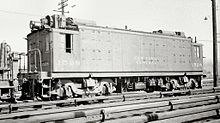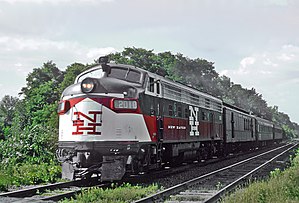EMD FL9
| EMD FL9 | |
|---|---|
|
FL9 2010 on the New York, New Haven and Hartford Railroad , 1968
|
|
| Numbering: | 2000-2059 |
| Number: | 60 |
| Manufacturer: | Electro-Motive Diesel (EMD) |
| Year of construction (s): | 1956-1960 |
| Axis formula : | Bo '(A1A) |
| Gauge : | 1435 mm ( standard gauge ) |
| Length over buffers: | 1798 mm |
| Service mass: | 130 t |
| Top speed: | 143 km / h |
| Hourly output : | 1305/1342 kW |
The FL9 is a series of diesel-electric locomotives from the General Motors Electro-Motive Division ( EMD ), which can also be operated purely electrically as dual-power locomotives .
prehistory
The tracks to the terminus Grand Central Station (since 1913: Grand Central Terminal ) in the Manhattan borough of New York City lay in a four-kilometer underground section from which the authorities wanted to ban steam operations as early as 1902 . Poor visibility in the smoke-filled tunnel led to a railway accident in February of that year with 15 dead and 41 injured. The conversion to electrical operation was required by law by July 1, 1908.

Approached was the station of the trains of the railway company New York Central and Hudson River Railroad (NYC & HR, later in the New York Central Railroad merged), which tracks the New York, New Haven and Hartford Railroad used (NYNH & HR). At the end of September 1906, the first section between Grand Central and High Bridge ( Harlem ) was electrified with side busbars and 650 V DC . The locomotives were changed at High Bridge station. By the beginning of 1913, the electrical network was expanded to a length of around 100 km.
The Pennsylvania Railroad (PRR) and its subsidiary Long Island Rail Road (LIRR) also electrified their inner-city routes with side busbars in those years. NYNH & HR, which had to use the NYC & HR system from Grand Central to Mott Haven Junction, electrified the onward route with overhead lines and alternating current of 11 kV and 25 Hz.
In order to be able to reach the major New York stations without changing locomotives , the companies procured multi-system locomotives and multiple units for two or even three power systems. An early example of this is the New Haven EP-1 , of which 41 machines were built between 1905 and 1908. Later, however, there was also the option of converting or building diesel locomotives accordingly. After all, in the USA it was generally a question of diesel-electric machines whose driving axles were moved by electric motors . Early two -power locomotives were the GE three-power boxcabs (built 1928 to 1930), Baldwin RP-210 from 1956 and the FM P-12-42 (New Haven version) from 1957.
History and description

The locomotives were built from 1956 to 1960 by the Electro-Motive Division of General Motors . The orderer and only customer was NYNH & HR. They made it possible for Deutsche Bahn to run passenger trains from non-electrified lines (e.g. from Boston or Springfield ) to Manhattan without changing locomotives.
With 60 machines, the FL9 became the most important series of two-engine locomotives in the USA. The basis was the FP9 , a four-axle diesel-electric locomotive from EMD, 90 of which was built from 1954 to 1959. Like those, the FL9 has only one driver's cab and the front known as the "bulldog nose", which was first used in the EMD E series . The FP9 and the first series of FL9 are with the 1,305 kW diesel engine payable 16-567 C equipped. In addition to the additional equipment for electrical operation, the FL9 received an enlarged steam generator for heating the passenger trains. The car body was stretched from 16.82 m to 17.98 m, due to the higher weight, the wheel arrangement was changed from Bo'Bo 'to the unusual arrangement Bo' (A1A). Both bogies of the five-axle locomotives have Flexicoil suspensions that leave enough space for the pantographs on the side . The middle axle of the rear bogie is not driven.
Since the electric traction motors of the FL9 - like those of the other locomotives in this family - run with a DC voltage of 660 V, they can be operated directly with the traction current from the conductor rails. The lateral pantographs are moved pneumatically. In electrical operation, the locomotive can be supplied via power rails painted from below or - in the LIRR network - from above. Since there are large gaps in the conductor rails in the switch areas of the Grand Central Terminal and Penn Station , overhead lines have been laid there. Therefore, the first thirty FL9s were equipped with small pantographs . A DC compressor provided the compressed air for the brake system in electrical operation .

The two prototypes and 28 machines of the first series were built from October 1956 to November 1957. The second series with 30 locomotives was built between June and December 1960. It no longer had a pantograph and had the 16-567 D1 diesel engine, which was more powerful with 1342 kW. Instead of the macro microphone, all FL9s had a Hancock air whistle as a signal transmitter, as is usual with the NYNH & HR . The locomotives were painted in the colors blood orange and black, with a white "bib" on the lower front section. The logo of the railway company, the letters N and H in a vertical arrangement, was emblazoned on the front and side .
With the delivery of the FL9, NYNH & HR decommissioned all older electric locomotives, only the ten three-system locomotives of the EP-5 series built in 1954 remained in stock. Compared to the retired machines, however, the FL9 turned out to be weakly motorized. After NYNH & HR was absorbed by Penn Central Transportation in 1969 , the machines were also used in freight transport and some were repainted in the colors of the new owner. On June 21, 1970, the new company filed for bankruptcy and continued to operate under insolvency administration.
Long-distance trains to and from Boston mainly used Grand Central Terminal in New York until September 21, 1970, while Penn Station from the north was served almost exclusively by continuous connections to destinations south of New York. In September 1970, all locomotive hauled long-distance trains were relocated to Penn Station. Since May 1, 1971, long-distance passenger transport has been carried out by Amtrak , which took over twelve FL9s.
Other locomotives of the series were used in suburban traffic, which from September 1970 was only run to and from the Grand Central Terminal. The Metropolitan Transportation Authority (MTA) began subsidizing these services in 1970. Some of the FL9 used here received the blue MTA livery with a yellow front, but all remained the property of Penn Central. These machines went to the Consolidated Rail Corporation (Conrail) in 1976, before they came to the MTA's Metro-North Railroad in 1983 and were given a new look. Several locomotives were rebuilt and modernized, ten of which were given the old NH color scheme.
Whereabouts

Six of the Amtrak machines - after modifications from 1978 onwards - were used until 1996. At the beginning of the 21st century, the FL9 were increasingly shut down, the last use in tourist traffic took place in 2009. Many locomotives have been preserved, but remaining machines can only be used in diesel mode.
Among other things, there are the locomotives 2005, 2011, 2024, 2026, 2049 and 2059, some with different company numbers. Locations include the Whippany Railway Museum in Whippany , the Connecticut Eastern Railroad Museum in Willimantic, and the Railroad Museum of New England in Thomaston . The FL9s can be seen in front of museum trains on the Cape Cod Central Railroad in Cape Cod and on the Orford Express in Magog ( Canada ).
Others
The 5048 locomotive from the second series was used in the 1978 film Superman .
Web links
Individual evidence
- ↑ Howard Johnston, Ken Harris: Jane's Train Recognition Guide . HarperCollins Publishers, London 2005, ISBN 0-06-081895-6 , pp. 415 .
- ↑ a b c Stefan Vockrodt: Electric to Manhattan . In: Railway history special . Railways in New York No. 1 , 2013, ISBN 978-3-937189-77-2 , pp. 50 ff .
- ↑ The ancestors: Locomotives of the F series from GM-EMD in: NOHABs (Eisenbahn Journal special edition 4/2003), p. 12 ff.
- ↑ Federal Railroad Administration (Ed.): History of Running Times / Passenger Trains Northeast Corridor . October 28, 1984, p. 6 ( dot.gov ): "Until September 21, 1970, regular trains to and from Boston used either Grand Central Terminal or Pennsylvania Station in New York. Generally speaking, trains originating or terminating in New York used Grand Central Terminal, while trains to and from points south of New York such as Philadelphia and Washington used Pennsylvania Station. Effective September 21, 1970, all regular trains to and from Boston have been using Pennsylvania Station only. "

